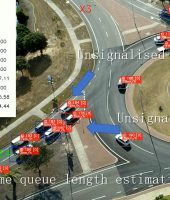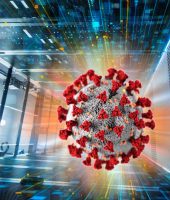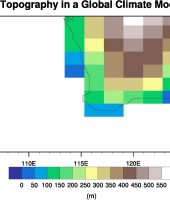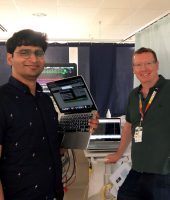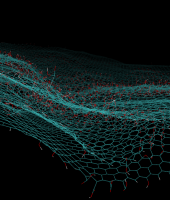HPC models over laboratories in drug discovery
Roughly 50% of the costs associated with the development of new drugs occur during drug discovery, this includes laboratory testing to identify promising molecules as drug candidates. A Pawsey Centre for Extreme Scale Readiness group has developed a computational model that could rival the accuracy of laboratory testing while also being cheaper.
The Challenge
Dr Giuseppe Barca is a high-performance computing (HPC) scientist at the Australian National University. He leads a Pawsey Centre for Extreme Scale Readiness (PaCER) group that models large molecule interactions. This model is unique because it uses information about the quantum properties of atoms to predict the behaviour of molecules more accurately.
The group built a model to improve the pharmaceutical drug discovery pipeline by simulating tests that would otherwise be performed in a lab. Laboratory testing is one of the most expensive aspects of drug discovery.
This approach is part of a field called structure-based virtual screening (SBVS). It is a new technology space that uses computational modelling to automate aspects of drug testing.
Traditional drug discovery often involves searching existing chemical databases housing millions of molecules to find drug candidates, and then physically testing them in a lab. SBVS automates the search for candidate drugs and calculates their affinity to a target protein. Drugs interact with human proteins to induce a medical effect. Often the stronger the affinity, the more powerful the effect. Finding drug candidates with affinity to a protein is one of the most important and difficult aspects of drug design.
Research, based on data from 47 companies between 2009 and 2018, estimated the mean R&D investment to bring a new drug to market to be US$1,336 million.
“My group is trying to solve the preclinical stage problem, where drug companies invest 50% of their time and money. How do you reduce this time and financial cost? If you have a fast computational pipeline – ideally as accurate as physical experiments – you could simulate the binding of all these new drugs,” says Giuseppe.
The challenge of SBVS is finding a balance between accuracy and speed for the computational simulations. Existing SBVS models use experimental data to predict the energetics and behaviour of molecules. These models simplify some molecular behaviour, and this can lead to bad recommendations.
The Solution
Giuseppe’s group aims to construct the first HPC pipeline that performs accurate quantum mechanical simulations during SBVS for drugs. Quantum mechanics can model the tiniest forces within molecules. These forces can add up to change the behaviour of molecules in ways standard physics systems can’t predict. By using quantum mechanics, this pipeline could reach the accuracy of physical experiments.
“To reach a level of predictive accuracy equal to experiments, you need to use modelling that is accurate at the quantum mechanical level. These are calculations which have been historically completely unfeasible beyond a few 100 atoms,” says Giuseppe.
In years 2020-2022, the group showcased the model’s efficacy using the Summit supercomputer at Oak Ridge National Laboratory. In 2021, they were able to model the energetics of a 60,000-atom protein at the quantum level, and later in 2022 of a 145,000-atom molecular material model. Now they are working on Pawsey’s Setonix supercomputer to adapt the model to a GPU-based platform.
“We are able to fully exploit the new generation of massively parallel supercomputers, which are based on 1000s of GPUs. Scaling means that the computational time goes down dramatically. The challenge has been moving from CPU to GPU computing.”
Giuseppe’s team is staffed by HPC experts, but he says Pawsey’s in-house experts helped with problem-solving and optimisation while porting the model into Sertonix. The group interfaced with Pawsey’s supercomputing applications specialists, Marco De La Pierre and Mehaboob Basha.
“With Pawsey, we have people we are interacting continuously with there. Marco and Basha are always working with us, we have open communication lines that we use every day. We keep solving problems and improving the program.”
The Outcome
Giuseppe’s group have successfully developed a model that uses quantum mechanical properties to simulate protein-drug interactions. Partnerships with the US Department of Energy Exascale Computing Project and the Pawsey PaCER initiative led to this new drug discovery model. The EXtreme-scale Electronic Structure System (EXESS) software can exploit thousands of GPUs to perform accurate quantum calculations on systems with thousands of atoms.
Giuseppe has co-founded a new company called QDX Technologies that leverages this new technology for solving drug discovery challenges by major pharmaceutical companies.
“We are already working on these problems at an industrial level. The practical outcome of this research is a technology that is industry ready,” says Giuseppe.
Quantum-level SBVS has the potential to reduce both time and cost of new drug discovery. The PaCER initiative helped Giuseppe’s team to train their EXESS software on GPU facilities. By using thousands of GPUs in parallel, they are able to model molecules consisting of thousands of atoms, which now has industry applications.
This successful collaboration between academic and industry partners highlights Pawsey’s role in facilitating cutting-edge HPC and its potential to drive innovation in critical research fields.
Project Leader.


